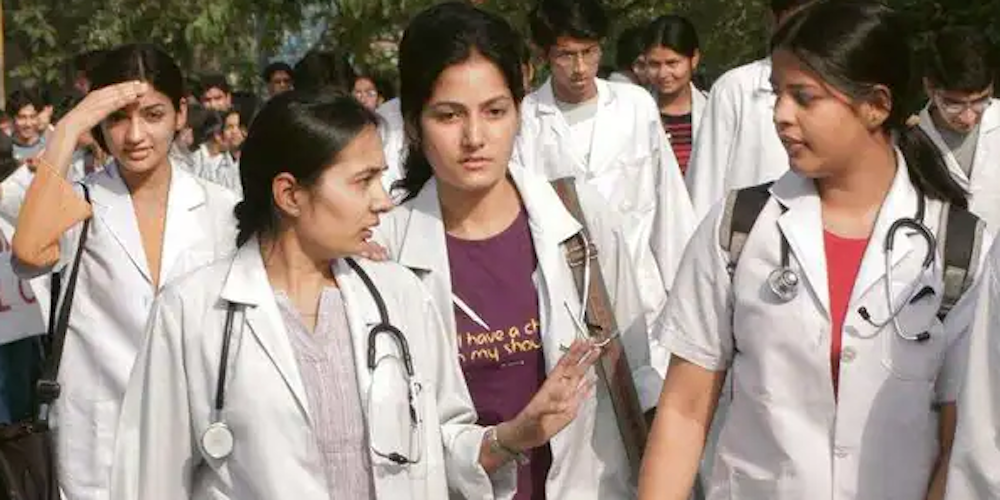Revolutionizing Medical Education in India

To improve the quality of life of citizens, access to affordable and quality healthcare services is extremely crucial. Recognizing this, over the last 9 years, the Indian government under the leadership of prime Minister Narendra Modi is said to have taken several initiatives to address this pressing need, such as encouraging the establishment of new medical colleges and AIIMS (All India Institute of Medical Sciences).
In just nine years, the number of medical colleges has risen by a staggering 70%, from a mere 387 in 2014 to 660 in 2023, along with an increase in the number of AIIMS from 7 to 22.
It is a matter of pride and satisfaction that India has witnessed a significant increase not only in medical colleges and AIIMS but also in the number of students being enrolled in medication education. Since 2014, there has been a 97% increase in the number of MBBS seats and 110% increase in the number of PG seats.
This remarkable growth reflects the government’s commitment to provide accessible and quality healthcare services to every citizen and the country’s unwavering resolve to build a healthier nation.
According to Union Health Minister Mansukh Mandaviya, a number of initiatives have been taken under the National Democratic Alliance (NDA) regime and that the changes can be seen happening in every corner of the country. With this momentum and coordination among stakeholders, a holistic ecosystem of education will be created in the country.
Highlighting the change in the medical education sector, Mandaviya said, “There is a paradigm shift from input-based to outcome-based approaches and reforms under the Modi government. Consequentially, we now have 648 medical colleges in 2022 with a whopping 96 pc increase in the number of Government Medical Colleges (GMC) alone and a 42 pc increase in the private sector, since 2014,” he said.
“At present, out of 648 medical colleges in the country, 355 are government and 293 are private,” Mandaviya added. The minister said, “MBBS seats have also seen a massive 87 per cent increase from 51,348 in 2014 to 96,077 in 2022. Similarly, PG seats have observed an increase of 105 per cent with 31,185 seats in 2014 to 63,842 in 2022.” He said with a vision to create 10,000 MBBS seats in government medical colleges, 58 colleges across 16 states have been approved with an increase of 3,877 MBBS seats.
Similarly, to increase PG seats, 72 medical colleges in 21 states and UTs have been approved in phase I, with an increase of 4,058 PG seats, he said. To create 4,000 PG seats in the GMCs, in phase II, a total of 47 colleges have been approved with an increase of 2,975 PG seats, he added.
To correct regional imbalances in the availability of affordable and reliable tertiary healthcare, Pradhan Mantri Swasthya SurakshaYojana (PMSSY) was launched, which targets the establishment of All India Institute of Medical Science (AIIMS) like institutions and the upgradation of existing GMCs by establishing super-speciality blocks in a phased manner.
A common entrance test- National Eligibility cum Entrance Test (NEET) for ‘one country, one examination, one merit’ system introduced in 2016 with a common counselling system allowed students from anywhere in India an opportunity to study in any medical college in the country based on merit.
The National Medical Commission (NMC) was also created to replace the highly corrupt body of the Medical Council of India (MCI). Before the NMC Act, there was no legal mechanism to regulate the fee charged by private colleges. “Now the guidelines in respect of fees for 50 per cent seats in all colleges including Government, Private and Deemed Universities have been released by the NMC, ” Mandaviya said.
Parallelly, reforms are ongoing in the sectors of nursing education, dental education and allied and healthcare professions, he said. “During Covid, we saw that our medical workforce played a crucial role of Covid warriors, but faced several challenges too like access to classroom education etc. In this regard, several steps were taken, DIKSHA platform (one nation, one digital platform) was one of them. It is the nation’s digital infrastructure for providing quality e-content for school education in states and Union Territories,” he said.
“QR-coded Energised Textbooks for all grades are available with 35 of the 36 states and UTs have now boarded on the platform and contextualised the content as per the local need,” the union health minister stated. He said, “Televised lectures for classes 1-12 through one class, one channel of Swayam Prabha initiative was well appreciated.” Other initiatives like Radio, Community Radio and CBSE Podcast- Shiksha Vani, special e-content for the visually and hearing impaired developed on Digitally Accessible Information System (DAISY).



